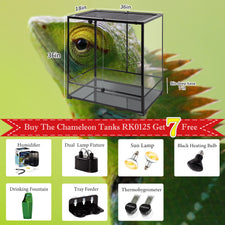Basilisks Care Sheet I REPTI ZOO

Do you know basilisk is a species of lizard? There are four main members of the Basilisks family, there are green Basiliscus, brown basilisk, common basilisk, and basiliscus galeritus. These four types of basilisks can run through the water at the speed of 8-10 km/hour, which is beneficial from their toes with skin flap to create life force while they are running, preventing from dripping.
The general life age for basilisks is five to six years and most of them are arboreal animals living in the jungle in Central America.
Basilisks Cages
Basilisks are very active and they need a wide and open space for living so vertical enclosures are the ideal habitat for them. To avoid violence between the basilisks, it is not suggested to put two adult men basilisks living together in the same enclosure although it is feasible to put a men basilisk living with a female together or a men basilisk with more than one female basilisk, in case they fight with each other for food or partner, raising single basilisks in a reptile terrarium is the best choice.
Enclosure Substrate
The volcanic soil and tree bark are recommended for use as the basilisks cage’s bedding. Volcanic soil has the advantage of high water-absorbing capacity, which can keep the reptile enclosure clean and healthy, Then, putting tree bark on the volcanic soil is a nicer decoration than coco-peat and moss because the latter might be eaten by basilisks accidentally.
Basilisks rely on water heavily as they need to shower and drink, a reptile water dish can improve the humidity in the reptile tank as well. Set up reptile a water dish and a sponge and check the cleanness every day.
Climbing & Background Accessories
Basilisks would like to hide behind trees or somewhere else when they are going to live in a new environment. In the beginning, problems such as being nervous, refusing to eat, and decreased immunity would be caused to basilisks so putting things like driftwood in their habitats can make them feel nice and comfortable. Additionally, bark background is nice to be used to create a natural bio-active habitat environment too.
Terrarium Humidity and Temperature
Basilisks prefer a high temperature and humidity living environment so heating lamps and sprays are a must for them. In regards to lamps, there are four lamps and a lamp fixture that we need to prepare before getting a basilisk. A lamp with intelligent control, a Reptile UVB bulb, a Reptile UVA bulb, a Reptile ceramic heating bulb, and a lamp fixture kit. Using a UVA sun lamp can increase the temperature in the enclosure, UVB lamp is helpful for basilisks to absorb calcium.
Temperature and humidity reference value
Temperature
Day Time: 30-35℃
Night Time 25-30℃
Humidity: 75-100%
Food
Basilisks mostly eat insects such as cockroaches, crickets, mealworms, barley pests, and suckling mice.
Feeding Frequency
The feeding frequency is getting longer since the growth of basilisks. Broadly, there are three main different stages:
Baby Basilisks ( 0 -3 months) - Feeding them cockroaches or crickets twice per day.
Sub-adult Basilisks (3 - 6 months) - Feeding them fish or insects once per day or thrice to fourth times per week.
Adult Basilisks ( older than 6 months) Feeding them fish, suckling mice, or living insects thrice to fourth times per week.
Equipment Preparation Lists
Step1: Lizard Enclosure
- Baby & Sub-adult Basilisks: 90x45x60cm
- Adult Basilisks:90x45x60cm or larger.
Step2: Habitat Decoration
- Reptile Volcanic soil / Treebark
- Reptile Tree vines / Driftwood / Moss tree vines
- Reptile Water Dish
- Reptile Bark tree background
Step3: Heating, Lighting, and Accessories
- Reptile intelligent lightbox
- Reptile Feeding pincers / Cleaning pincers
- Reptile UVB bulb
- Reptile UVA bulb
- Reptile ceramic heating bulb
- Reptile lamp fixture
- Reptile Automatic sprayer equipment
- Living insects food











